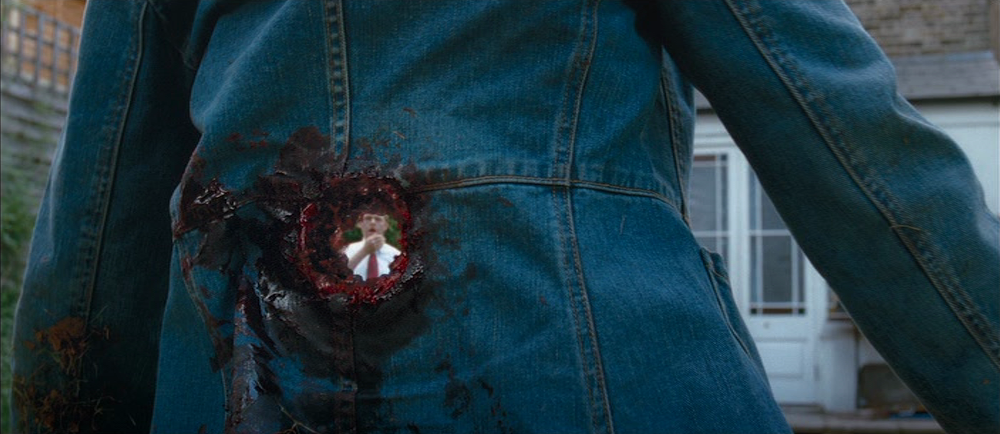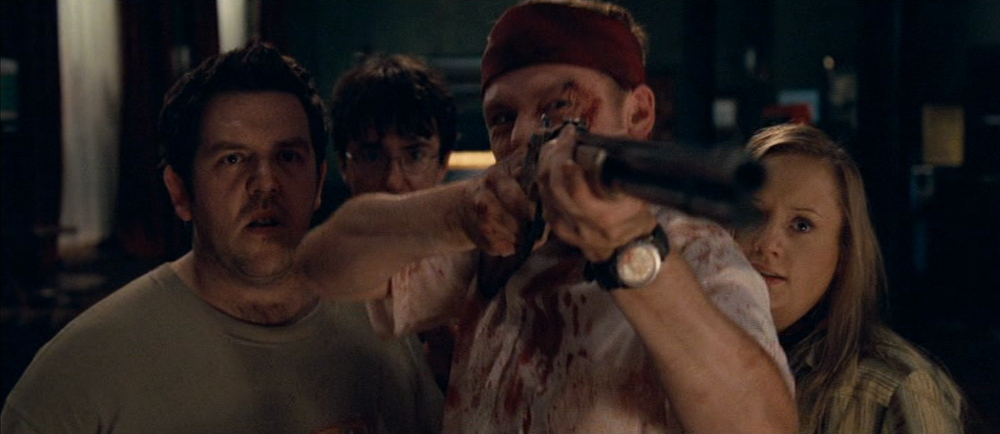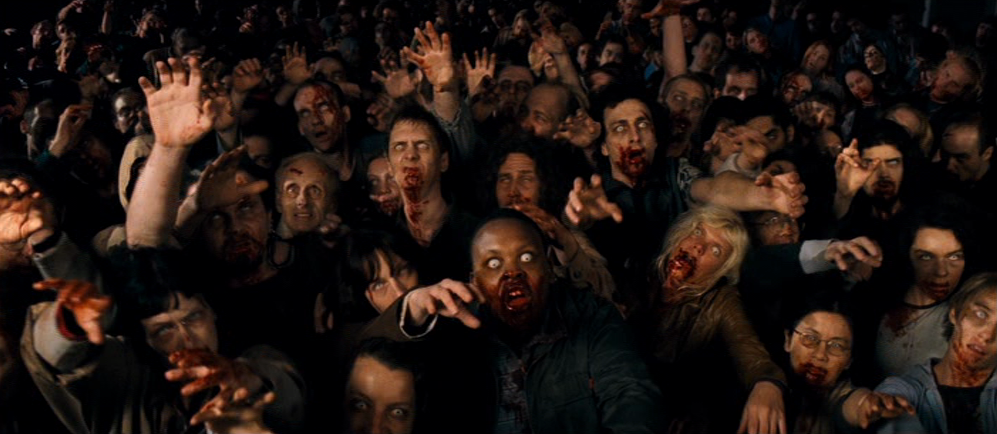Last Friday night, I reminded Anne that it was her turn to pick our date-night movie. This is never a simple task for either one of us. And so, a familiar struggle ensued.
Anne ascended the stairs to browse our film library while I prepared the snacks. She returned with an armload of “possibilities” — the usual pile of twelve or more. That meant it was my job to examine the options and narrow it down. Normally, Anne favors science fiction, fantasy, romantic comedy, or documentaries that focus on natural wonders (Planet Earth, for example). But this time the selections were surprisingly eclectic. They included little-known titles like Aaltra, popular favorites like Napoleon Dynamite, and three Criterion titles: Short Cuts, Punch-drunk Love, and The Burmese Harp.
After I cut the list in half, we discussed the remaining options. And she finally admitted that she had an obvious preference. I might have guessed. And I didn’t object. We were tired. We were in the mood for something familiar, something funny, something somewhat frivolous. We were in the mood for Edgar Wright’s Shaun of the Dead.
Anne and I first watched this cult-classic zombie movie on my birthday in 2004. I think it was the film’s first week in theaters.
I remember being pleasantly surprised by the complexity of Shaun‘s humor; the confidence of the two leads — Simon Pegg and Nick Frost; the chemistry of the endearing characters in their community; the colorful and detailed locations; the supreme confidence of director Edgar Wright’s editing and pacing; and, above all, Wright’s ingenious fusion of imagery and music, which made the film feel like a wild ride in a flashy car driven by a professional. This movie has the stylish sizzle of Guy Ritchie’s Lock, Stock, and Two Smoking Barrels, but it also proved that even the most incidental details had been carefully devised to reward those paying attention.
Now, here we are — thirteen years and two sequels later. Hot Fuzz and The World’s End aren’t exactly proper sequels, but Wright crafted those standalone stories with Pegg and Frost as their common denominators and plenty of clever connections to delight the first film’s fans. And yes, Wright is still the man. “The Cornetto Trilogy” has far more strengths than weaknesses, and it reveals Wright as a master of invention. Give him a formula and he’ll find all kinds of ways to surprise you while remaining faithful to the basic beats. I can’t wait to see his latest — Baby Driver — because, as Anne and I revisited Shaun of the Dead, I could see just how many years he has been practicing the kinds of sequences that look likely to be the building blocks of that particular project (in which, quite literally, a professional driver takes his cues from the movie’s slick soundtrack).
But this particular run down Shaun’s zombie-crowded streets was surprisingly complicated for me — for three reasons.
The first…
…well… it’s not exactly new.
Even the first time I saw Shaun of the Dead, I was uncomfortable with its concessions to the genre’s demand for scenes of extravagant gore (especially one graphic disembowelment, which seems to be staged to satisfy viewers whose patience for the annoying victim has run out). I have no problem with violent sequences in movies if they contribute meaningfully and artfully to the whole of a vision. But I have always preferred those films that leave much to the imagination over those that indulge in Grand Guignol excesses.
Why? Gore is a standard of the genre, right? Why not just roll with it? Everybody knows it’s make believe.
I wish that I could leave it at that. But the fact is that I always feel strange pangs of conscience when big-screen artists treat lightly the image of a human body’s destruction, no matter how far that bloodied character might have fallen from our favor. It always feels to me like a kind of pornography, something that fails to contribute to meaning of the whole, and that exists to inspire — at best — a rush of adrenaline and — at worst — a kind of perverse delight at its grisly realism.
And I suspect that this deep-rooted objection to the sight is amplified by another truth: I live in awe of the beauty and complexity and seeming impossibility of the human body. It wounds me to see it disgraced and destroyed. And some of the moments of visible carnage in this film — like those in so many horror films — have given me a sense that I’ve been harmed by seeing in a way I wouldn’t have been harmed by imagining.
I bear scars from a certain scene that I witnessed in an otherwise remarkable 2015 Western starring Kurt Russell and Richard Jenkins: Bone Tomahawk. That film, following in the paces of The Searchers, leads its team of rescuers on a descent into a hell of barbaric and demonic villains that culminates in a scene of graphic dismemberment that I wish I could surgically delete from my memory. If it had been left to my imagination, I could have coped with it better. Nothing in Shaun disturbs me as much as that. To be honest, nothing in The Passion of the Christ disturbed me like that scene.
I feel more than just “Eww, gross” when I witness abuse to the human body. I feel a deep tremor that says “These images are doing you injury.”
I find this difficult to understand and explain — but there it is. I’m not saying that all moviegoers should look away or turn it off. I’m not seeking to make moviegoers feel guilty for liking films that include graphic violence. I’m just saying that I am realizing something about my own imagination, and that I want to express it in the hopes of encouraging others to be honest about their own complicated relationships with art. It doesn’t mean that you have a weakness if certain kinds of artistic expression do you more harm than good; it’s nothing to be ashamed of. Indeed, it might actually be a testimony of your strength. We need to be true to our experiences, and to that subtle voice of conscience that reminds us “All things are lawful, but not all things a profitable. Be wise.”
Secondly…
…watching Shaun this time, I realized just how changing times can affect the ways we experience art.
The events of the past year have shown me just how deeply divided my American community has become. They have shown me the intensity of partisan hatred among Americans: the unwillingness of people in one camp to listen to those in another, the eagerness with which we believe the worst about each other (in order to reinforce our sense of correctness), and the frightening capacities we have to brand and condemn whole communities based on ignorance. We are more obviously divided. And we are divided in more ways than ever — chasms widening between rich and poor, right and left, generation and generation, race and race.
In this context, I find that I can’t easily laugh off even cartoonish clashes like these — the clashes between the living and the “undead.” I’m increasingly skeptical of any art that simplifies a story as a struggle between two camps, one of which is “good” and one of which is “evil.” The more life that I experience, the more I see currents of evil running through all of human endeavor, corrupting both sides of any debate, and separating the strong from the weak within any community or category. I can’t cheer as Shaun and Company determine that the only reasonable response to the advancing hoard of zombies is to smash them to pieces — even though that’s exactly what the zombies mean to do to them.
I’ve always had a difficult time laughing at how this wacky comedy gets to its “happy ending” … after forcing characters into scenarios where they have to blast their own family members’ heads open with shotguns. No amount of wink-wink genre conventionalism can make me see this anything but a contribution to our problems. Sure — scenes like that are what make this an honest-to-goodness genre movie. Audiences expect those moments. They give these movies a structure within which the artists can distinguish themselves by their variations. But that doesn’t diminish the fact that I’m being asked to watch a son pick up a shotgun and blast a hole the size of a Mason jar in his own mother’s head, even as he weeps for what has become of her; and then I’m quickly carried past that moment to the next wacky scenario, without further respect for, or reflection on, what has just taken place.
Even if all of this violence is clearly conceived as satire, I wonder: How much more harm than good will a movie like this do if its catharsis speaks to our desire to write off, “block,” or otherwise eliminate those factions of people who trouble us? In this climate of violent partisanship, how likely are zombie movies to appeal to our desires to judge and condemn our neighbors on the other side of the fence? Might this genre be appealing to — and, worse, empowering to — those who perceive that people of other races, religions, or political persuasions are merely mindless aggressors?
Yes, Shaun of the Dead shows us other possibilities. It’s final moments show a society trying to make good use of the zombies, giving them a meaningful function instead of merely exterminating them. But it felt — this time, anyway — like too little, too late.
Why was Shaun so much easier to enjoy the first time around? Back in 2004, it seemed as though I was watching the film in an entirely different world. I did not feel burdened on a daily basis by the cruelty of American culture. In recent days, I’ve felt soul-sickened at my fellow Americans’ increasing support for acts that increase their own security and safety at great cost to others’ human rights and resources. This rising tide of self-centeredness and pride feels like an epidemic that, in the name of militant tribalism and racism, makes people willing to sacrifice honesty, human decency, and community. This nationalism, this sense of religious superiority — it runs directly contrary to the Gospel that I embrace, the Gospel that calls me to open my arms at the threat of violence from others, that tells me not to fear death, that asks me to show love in response to hate, to offer welcome in response to aggression.
If I believe what I say I believe, then I must admit that a philosophy summed up as “Aim for the head!” doesn’t work. And that goes for language about trying to forcefully persuade others toward my way of thinking just as it goes for trying to physically hinder them from advancing.
Don’t take this as a condemnation of the zombie genre: I’ve defended zombie movies, horror movies, and tales of the apocalypse many times before. I stand by those defenses. Many of them raise questions about conscience, about the dangers of us-versus-them dichotomies, about what compromises we will strike to stay alive.
Take this instead as a testimony of transformation and discomfort. As the world around us changes, the art that it needs changes too. Perhaps if I experience a restoration of faith in my community to love the outsider and “reach across the aisle,” I will have the luxury of finding comedies about tribalism and zombie wars funny again.
But right now, a lot of things that used to be funny because they seemed exaggerated or ridiculous… well, they aren’t so funny anymore. They’re pounding on my door and snarling. They’re leaving bloody handprints on the window. They have contempt for my attempts to think things through and respond with reason, conscience, and facts. They’ve given up their own intellects, and, if they get their way, they’ll come for your brains too.





It is always a pleasure and often a blessing to read your commentary. Thank you.
May I ask: if you knew a movie was going to contain gratuitous, “extravagant” gore would you still watch it? Would you watch Shaun of the Dead again?
I think the answer is “It depends.” If reliable sources convinced me that the gore was realistic, excessive, and disturbing, I would probably steer clear. If it’s something I know is coming, I have the freedom to look away. (I’ve wanted Shaun of the Dead many times. In recent viewings, I’ve just used “that scene” as an occasion to go to the kitchen for a snack. But I will never watch Bone Tomahawk again — I was scarred by that when I was blindsided by the graphic nature of its most horrifying scene.)